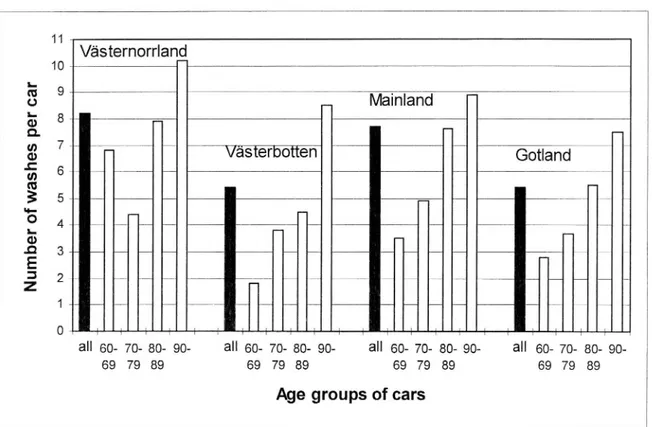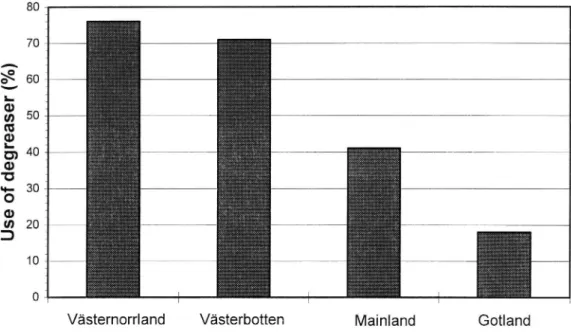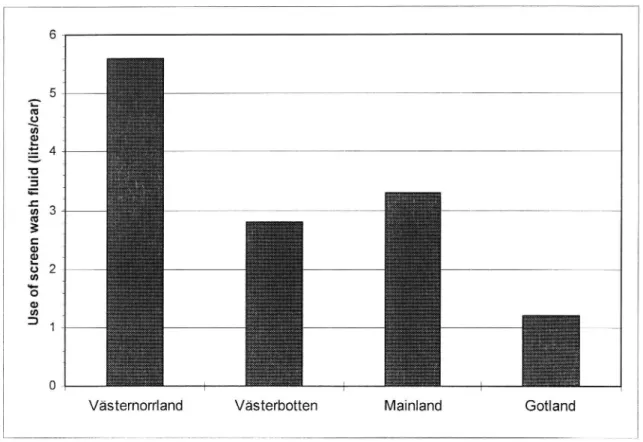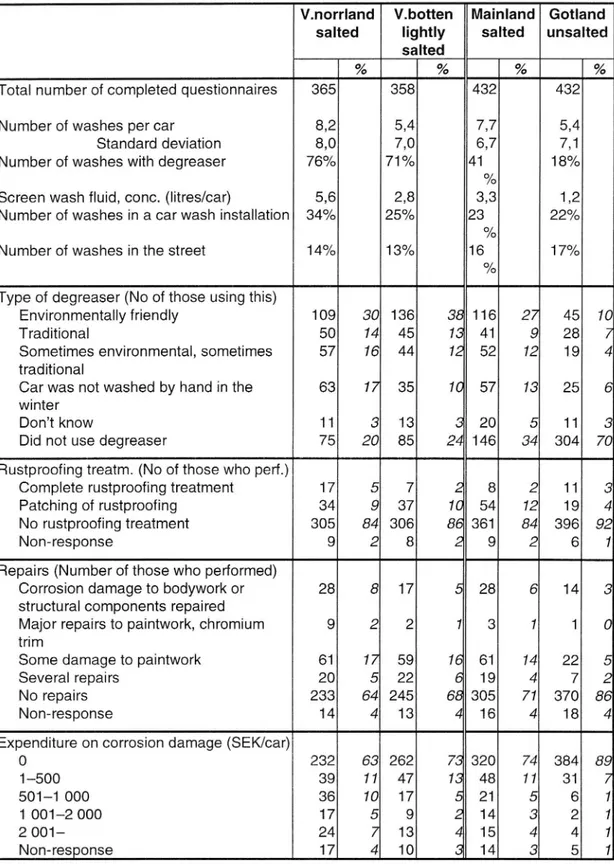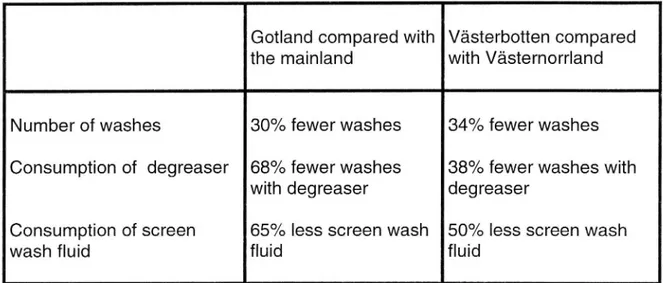Secondary Environmental Impact
Due to Winter Road Salting
Reprint from Technical Report Volume 3, pp 1033-1042,
Xth PIARC International Winter Road Congress,
16 19 March 1998 in Luleå, Sweden
Eva Gustavsson and Janet Yakoub
oo O') m vi
en
c» N x 0 > h uH h 35 U) ,. C |-m y && 50 E N Franc, &
Swedish National Road and
VTI särtryck 293 - 1998
Secondary Environmental Impact
Due to Winter Road Salting
Reprint from Technical Report Volume 3, pp 1033 1042,
Xth PIARC International Winter Road Congress,
16 19 March 1998 in Luleå, Sweden
Eva Gustavsson and Janet Yakoub
,
institute
? fä? 5
Secondary Environmental Impact Due
to Winter Road Salting
EVA GUSTAVSSON, JANET YAKOUB
Swedish National Road and Transport Research Institute 581 95 Linköping
Sweden
ABSTRACT
The term secondary environmental impact refers, inter alla, to the
environmental impact which may arise if, because vehicles etc become dirtier, they have to be cleaned more often and this increases the
emissions of vehicle care products. Our aim is to find whether winter road salting affects wash frequency, the use of car cleaners and corrosion. Compilation of the responses shows that there are significant differences in the care of cars between Gotland (unsalted) and the mainland opposite
Gotland (salted), and between part of Västerbotten County (lightly salted)
and part of Västernorrland County (salted). We consider that if salt application were discontinued, wash frequency would be cut by ca 30% and the use of degreasers and screen wash fluid would be reduced by
40-70%.
We formulated our study as a questionnaire survey. Responses were received from 1587 car owners, 70% of the sample.
Secondary Environmental Impact Due to Winter Road Salting
Winter road salting has been the subject of increasing discussion in recent years, mainly because of the environmental effects it gives rise to. The primary environmental impact consists of the direct effect which salt has on plants, animals, lakes, watercourses and groundwater near the road. The term secondary environmental impact due to winter road salting refers, inter alia, to the environmental impact which may arise if vehicles
etc have to be cleaned more often because they become dirtier. Previous
research projects have demonstrated that roads on which salt has been spread in winter do make vehicles dirtier than roads on which sand has been spread (Helmers & Ytterbom, 1986).
AIM AND LIMITATIONS
The aim of this investigation is to find whether or not secondary
environmental impact as a result of salting occurs. Our hypothesis is that application of salt has an effect on the frequency of washing vehicles, the use of vehicle care products and screen wash fluid, corrosion attack and the frequency of use of rustproofing preparations, and we test this
hypothesis by comparing regions with different salt application strategies. What we are mainly investigating are wash frequency and the use of degreasers and screen wash fluids, i.e. the second link in the causation sequence from salt application to damage, as shown below.
E%?) Washes
%® |Emissions|%® |Damage |
Use of chemicals
METHOD
Gotland in the south and the areas around E4 in Västerbotten in the north seemed to be the most interesting areas to investigate as regards the use of vehicle care products, as the roads on Gotland are not salted and the highway in Västerbotten is considerably less salted than the same
highway farther south. Reference areas should have the same climate as the areas to be investigated so as to minimise the effect of different weather and road conditions. For Gotland the suitable reference area is the mainland opposite Gotland, and for Västerbotten County the
We used questionnaires to collect data on how private car owners clean their cars on the island of Gotland (no salted roads) and part of
Västerbotten County, and compared these with data relating to regions with a similar climate (the coast opposite Gotland and part of
Västernorrland County respectively).
Of 2257 car owners selected at random, 1587 fully answered the questionnaire. The response rate was thus 70.3%.
RESULTS
Evaluation of the answers to the questionnaire shows that there are clear differences in the cleaning of cars between the island of Gotland in the south (unsalted) and the mainland opposite Gotland (salted), and between part of Västerbotten County in the north (lightly salted) and part of of Västernorrland County (salted). These differences are significant at the S% level.
There are relatively large differences in climate between the north and
south of Sweden, and these are probably of great importance for the more frequent use of degreasers and screen wash fluid, and the higher wash frequency, in the north. Another factor which may be important is that in winter more cars have studded tyres in the north than in the south. It is therefore not relevant to compare test areas in the north with those in the south.
There is a clear difference in wash frequency during the winter between Gotland and the mainland: 5.4 washes per car as against 7.7. ln
Västerbotten and Västernorrland the difference is slightly larger, 5.4 and 8.2 washes per car respectively. See Fig. 1.
_ X _ _ X
Västernorrland 10 _ "" 9
8
Mainland
r
L- 8 _ (D _ __ Q- . 7 _ _ .. __ _& Vasterbotten Gotland
.: 6- __ __ __ w N
3 5
_
_
q- _ ° 4- _ __ _ __ __33
_
r
Q 3 _ _ _ _ F __ __ _å
2 _ _. _ __ _ __ _ _ z 1~ i _ _ f _ _ _ O a l : l l l : l l : % l l l l i : l l i i l , all 60- 70- 80- 90- all 60- 70- 80- 90- all 60- 70- 80- 90- all 60- 70- 80-90-69 79 89 69 79 89 69 79 89 69 79 69 Age groups of cars
Figure 1. Average number of washes per car in winter in different regions
and for cars of different ages
On the island of Gotland, degreasers were used in only 18% of washes, while car owners on the mainland used these in 41% of washes. In the test region in Västerbotten, degreasers were used in 71 % of washes, as against 76% in Västernorrland. See Fig. 2.
Us e of de gr ea se r (% )
Västernorrland Västerbotten Mainland Gotland
Figure 2. Percentages of the total number of washes in which a
degreaser was used
Two thirds of car owners on Gotland used no degreasers at all, while the corresponding proportion on the mainland was considerably less than one third. One fifth of all car owners in Västerbotten and one eighth in Västernorrland used no degreaser at all during the Winter.
Us e of sc re en wa sh fl ui d (l it re s/ ca r) c o
Västernorrland Västerbotten Mainland Gotland
Figure 3. Use of concentrated screen wash fluid, litres/car, in the different
regions.
On Gotland, considerably less screen wash fluid was used (1.2 litres during the winter) than on the mainland (3.3 litres). A difference of the same order was found between Västerbotten (2.8 litres) and
Västernorrland (5.6 litres). See Fig. 3.
Repair of corrosion damage and rustproofing treatment were carried out by a rather few car owners, and therefore, no sound conclusions can be drawn from these data on this subject.
The questionnaire also put questions on where the car was washed. The percentage of washes in car wash installations and the percentage of washes in a paved street, parking space and drive does not follow the same pattern as the other variables. ln Västernorrland washes in car wash installations are considerably more usual than in the other regions. In the southern survey regions a higher percentage of washes occurred in the street than in the northern regions.
Table 1. Summary of responses to the questions in the form
V.norr|and V.botten Mainland Gotland salted lightly salted unsalted
sahed
% % % %
Total number of completed questionnaires 365 358 432 432 Number of washes per car 8,2 5,4 7,7 5,4 Standard deviation 8,0 7,0 6,7 7,1 Number of washes with degreaser 76% 71 % 41 18%
%
Screen wash fluid, conc. (litres/car) 5,6 2,8 3,3 1,2 Number of washes in a car wash installation 34% 25% 23 22%
%
Number of washes in the street 14% 13% 16 17% %
Type of degreaser (No of those using this)
Environmentally friendly 109 30 136 38 116 27 45 10 Traditional 50 14 45 13 41 9 28 7 Sometimes environmental, sometimes 57 16 44 12 52 12 19 4 traditional
Car was not washed by hand in the 63 17 35 10 57 13 25 6 winter
Don t know 11 3 13 3 20 5 11 3
Did not use degreaser 75 20 85 24" 146 34 304 70 Rustproofing treatm. (No of those who perf.)
Complete rustproofing treatment 17 5 7 2 8 2 11 3
Patching of rustproofing 34 9 37 10 54 12 19 4
No rustproofing treatment 305 84 306 86 361 84 396 92
Non-response 9 2 8 2 9 2 6 1
Repairs (Number of those who performed)
Corrosion damage to bodywork or 28 8 17 5 28 6 14 3 structural components repaired
Major repairs to paintwork, chromium 9 2 2 1 3 1 1 0 trim
Some damage to paintwork 61 17 59 16 61 14 22 5 Several repairs 20 5 22 6 19 4 7 2 No repairs 233 64 245 68 305 71 370 86 Non-response 14 4 13 4" 16 4 18 4 Expenditure on corrosion damage (SEK/car)
0 232 63 262 73 320 74 384 89 1 500 39 11 47 13 48 11 31 7 501 1 000 36 10 17 5 21 5 6 1 1 001 2 000 17 5 9 2 14 3 2 1 2 001 24 7 13 4 15 4 4 1 Non response 17 4 10 3 14 3 5 1
DISCUSSION
There are quite large differences in climate between the north and south of Sweden, and these are probably very significant regarding the greater use of degreasers and screen wash fluid and the higher frequency of washes in the north. lt is consequently impossible to draw any conclusions
regarding the effect of salt from comparisons between north and south. In
the following, comparisons will therefore only be made between the pairs
of regions Gotland-Mainland and Västerbotten-Västernorrland.
Can the differences between regions have a cause other than application of salt?
There are several dissimilarities apart from the differences in skid
prevention strategies between the salted and unsalted regions, and these may be significant for the factors which we measure. Breakdown of the car population by age is similar in Västerbotten and Västernorrland, but there is some difference between Gotland and the mainland. Our data cannot provide any information on the extent to which this is attributable to
Gotland's freedom from salt during the past ten years. Economic, social
and cultural differences may play a part. Obviously, such factors may also
have a certain effect on how clean it is considered a car should be, and they may consequently also affect wash frequency and the use of
chemicals. It is however not improbable that ten years' freedom from salt and the lower frequency of repairs of corrosion damage on Gotland are related.
Car use on Gotland is appreciably different from that on the mainland.
Journeys are seldom long since it is not usual to travel to the mainland by
car. Nor has Gotland any through traffic like the coastal region opposite the island. The topography on Gotland is also distinctive: the island is very flat, which facilitates skid prevention and thus the abolition of salt
appHca on.
Tyre studs are used to a considerably greater extent in the north of Sweden (more than 80% on average in winter) than in the south where the figure is between 30 and 50% (Jacobson, 1996). When application of salt on Gotland was stopped in 1986, the use of studded tyres increased from 74 to 80% (maximum, highest percentage in winter), but it changed at the same time and in a similar way in the Västervik area where the same salting strategy as before was retained (Öberg, 1991). There are no data of more recent date for the regions to which we sent questionnaires. Use of studded tyres has great significance regarding the quantity of asphalt particles that are torn out and adhere to the paintwork.
Consumption of screen wash fluid may be related to traffic density. The
more often a car is overtaken or passes another car, the more probable it is that the windscreen becomes dirty if the road is covered in slush.
Some differences in relative car ownership between men and women can also be discerned in the different regions. Men wash their cars more often
than women. Whether this is due to the fact that men, on average, have
newer cars and new cars are washed more often than older ones (see
Fig. 1), or whether it is because men and women have different attitudes
to their cars, is not certain. Variance analysis shows, however, that the
above differences in wash frequency and the use of screen wash fluid between salted and unsalted regions are significant, even when allowance is made for the sexes of owners, age of car or distance driven in winter. The results of the survey may have been influenced so as to make the differences larger than they are in actual fact by the somewhat unfortunate formulation of paragraph 1 of the first covering letter. It is pointed out there that skid prevention measures are one of the reasons that cars get dirty. The people interviewed are well aware of what method of skid prevention is used in the area where they live, and they might have been influenced by this. It is considered however that this could not have resulted in more than a marginal increase in the differences measured.
What if the whole of Sweden were to become salt-free?
What would happen if application of salt were discontinued in the whole of Sweden? Our investigation areas are not fully representative of the
country as a whole, but comparisons between pairs of these may provide some indication. For instance, if we make a projection from the results for Gotland and the mainlandl, consumption of degreasers would be reduced by 68%. See Table 2. This assumes that the same amount of degreaser is used in every wash regardless of whether or not the roads are salted. Our data can provide no information whether the dosage of degreaser is the same with and without salt application.
1 On the mainland, 41% of all washes in winter have degreaser added, i.e. 41 washes out of 100 (see Fig. 2). On unsalted Gotland the corresponding gure is 18%, and in addition the total number of washes is smaller, 70% of that in a salted region. Out of 100 washes 70 will thus remain when no more salt is
spread, and degreaser is used in 18% ofthese, i.e. in 13 washes. A reduction from 41 to 13 washes is a
10
Table 2. Percentage difference between salted and unsalted regions
regarding number of washes and the consumption of degreaser and screen wash fluid
Gotland compared with the mainland Västerbotten compared with Västernorrland Number of washes
Consumption of degreaser
Consumption of screen wash fluid 30% fewer washes 68% fewer washes with degreaser65% less screen wash fluid
34% fewer washes
38% fewer washes with deg reaser
50% less screen wash fluid
ln certain cases there are striking differences between Gotland and the mainland, while the corresponding differences between Västerbotten and Västernorrland are less pronounced or non-existent. This may at least partly be due to the fact that Västerbotten has not been completely salt-free; small quantities of salt had been spread, especially in the autumn of 1995. As regards wash frequency and the use of screen wash fluid, there
are evident and similar differences in both pairs of regions. On the other
hand, there is much more difference in the use of degreaser between Gotland and the mainland than between the two northern regions.
lnvestigations of wash frequency by the National Board for
Consumer Policies
Previous investigations by the National Board for Consumer Policies (Konsumentverket, KV) of car maintenance by Swedish car owners (e.g. KV, 1993) show that the average car owner washes the car about 20 times a year. The most recent investigation by KV (KV, 1995-96) sets separate questions for the winter months, November - April, and the summer months, May - October. According to KV, private car owners wash their car on average 8.1 times during the winter months and 9.9 times during the summer months. The figures of KV for the winter months may be compared with ours: 7.7 washes in a salted region in the south of Sweden and 8.2 washes in a salted region in the north. Note that KV's winter period is a little shorter than ours, and that KV's population of cars comprises only models since 1980. We have not put any limits on the age of a car. Fig. 1 shows that new cars are washed more often.
11
CONCLUSIONS
This study demonstrates that secondary environmental impact due to salting does occur. We can state that application of salt contributes to
higher wash frequency and increased use of chemicals for the care of
cars. There are significant differences between both Gotland and the mainland and between Västerbotten and Västernorrland where the differences in salt application rate are comparatively smaller.
If salt-free winter road management were to be introduced, this would
therefore mean that a smaller quantity of chemicals is needed for cleaning
and for rustproofing, and that vehicles may last longer. The use of degreasers would be appreciably reduced if application of salt ceased, perhaps to one half of their present use.
Bibliography
Helmers, Gabriel & Ytterbom, Uno, 1986: Saltningens inverkan på
väglagets smutsighet. (The effect of salt application on the dirtiness of roads). (ln Swedish). VTI Report No 286, National Road and
Transport Research Institute VTI, Linköping.
Jacobson, Torbjörn, 1996: National Road and Transport Research
Institute VTI, Linköping, personal communication.
KV 1993: Bilunderhåll, Attityder Beteenden Problem Kostnader. (Car
maintenance, Attitudes Behaviours Problems Costs). (In Swedish). Report No 1992/93:25, National Board for Consumer Policies, Stockholm.
KV 1995-96: Bilunderhåll 1995-96, Tabeller. (Car maintenance 1995-96,
Tables). (ln Swedish). T-11161, National Board for Consumer Policies,
Stockholm.
Öberg, Gudrun, et al, 1991: MINSALT Försök med osaltade vägar.
(MINSALT Tests on unsalted roads). (ln Swedish). VTl Bulletin No
